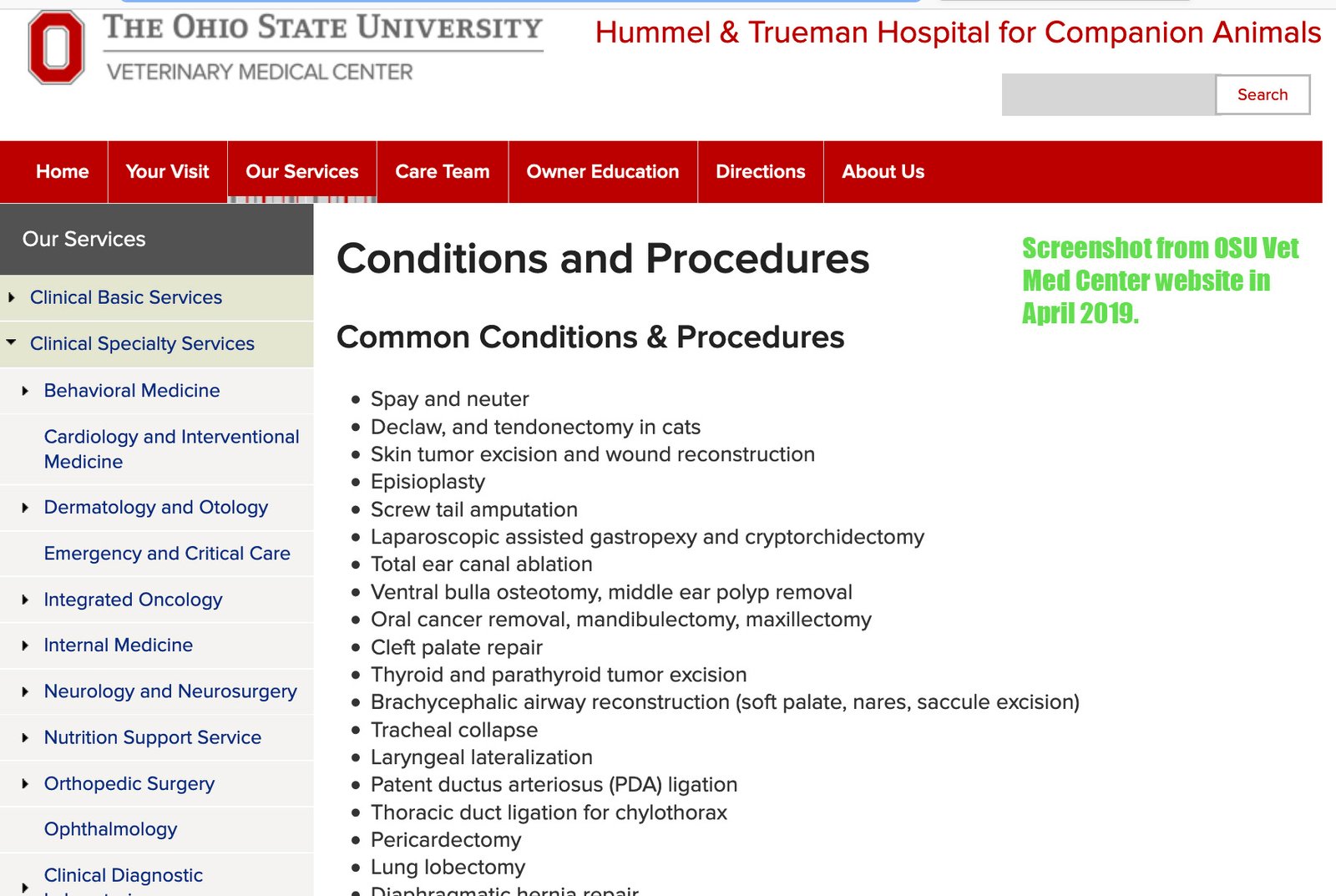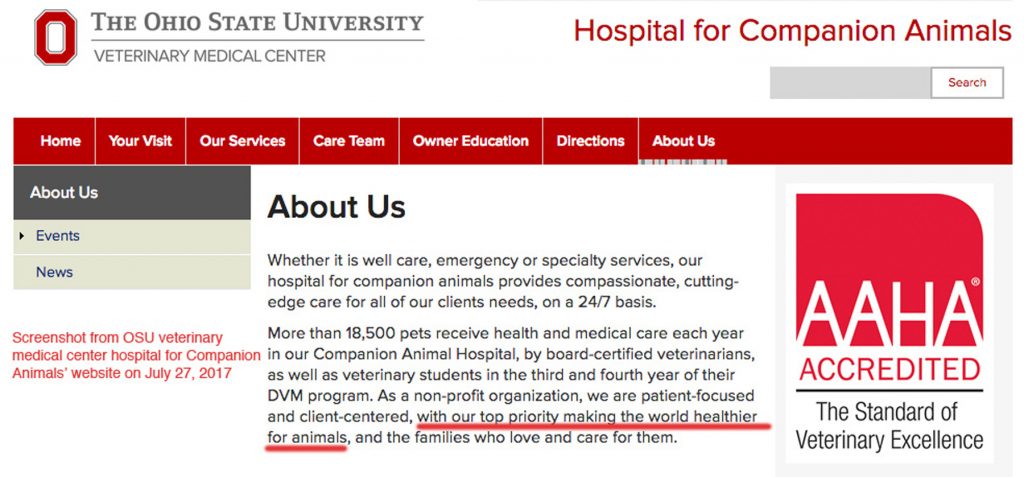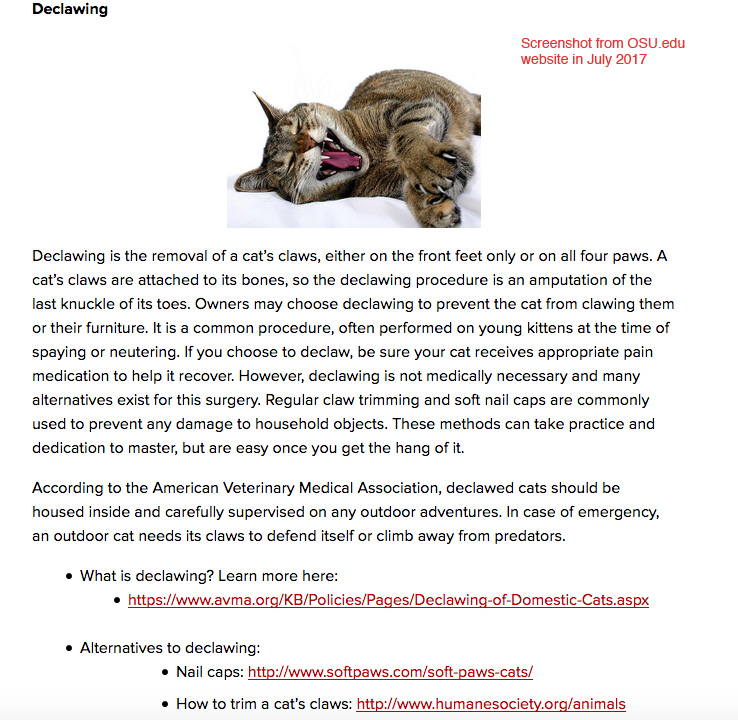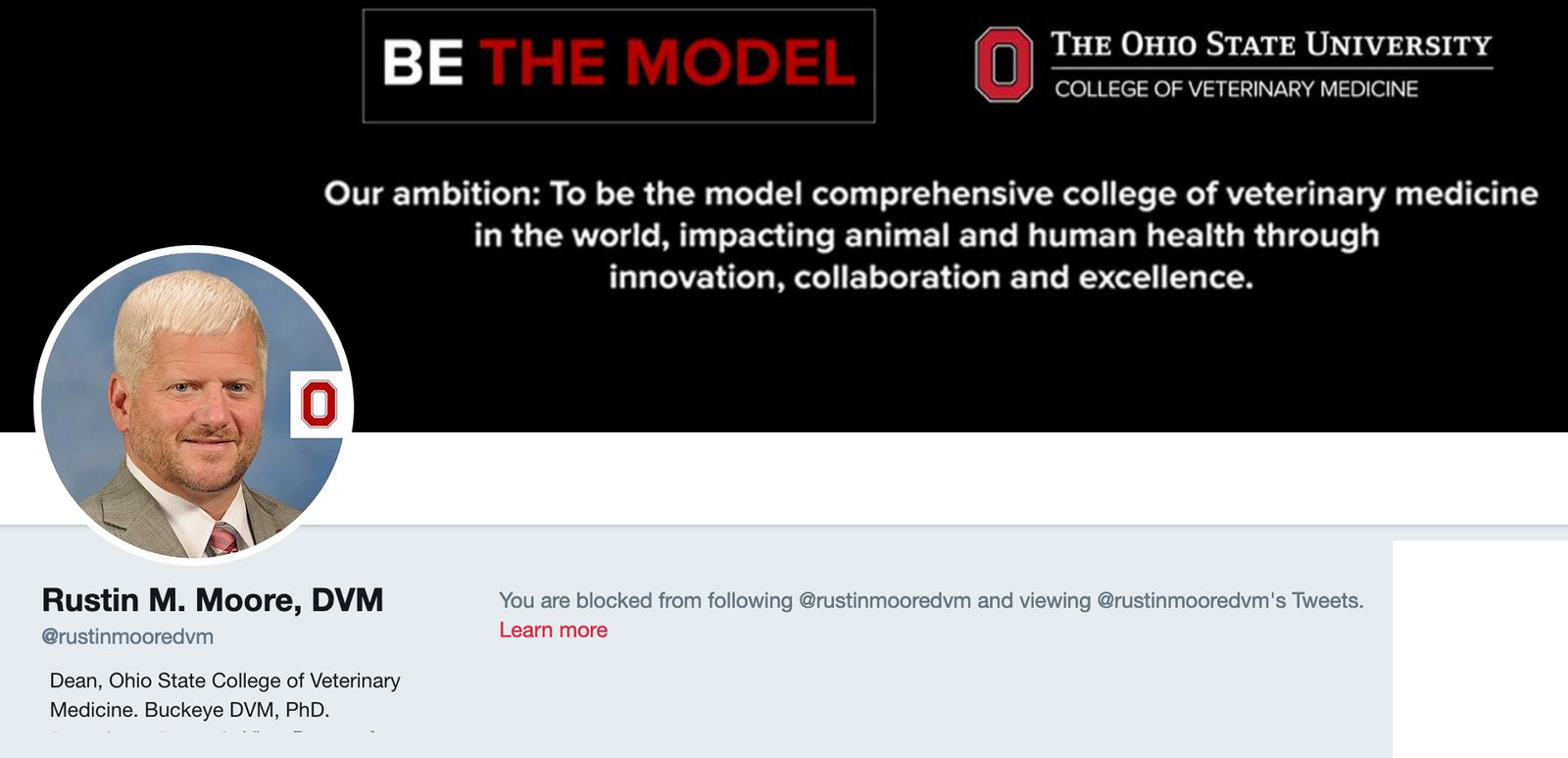UPDATE JULY 2021. Ohio State University opened a brand new clinic on June 1, 2021, the Frank Stanton Veterinary Spectrum of Care Clinic. We found out that the “higher ups” are deciding if they will continue to perform declawing services in their new clinic. Ohio State Medical Center has been a Cat Friendly Practice.
We checked and last year they were certified as a Cat Friendly Practice. The American Assoc. of Feline Practitioners (AAFP) announced late last year that they will not allow their Cat Friendly Practices to declaw cats.
According to catvets.com, Ohio State University’s clinic is no longer listed as a Cat Friendly Practice. We reached out to their Dean, Rustin Moore, to ask him if they are going to keep declawing and haven’t heard back from him.
Could it be that Ohio State decided to no longer be a Cat Friendly Practice because they wanted to continue profiting from declawing cats? If so, they should designate their new clinic as a Cat Unfriendly Practice.
Update Dec. 2020- Ohio State is still declawing cats. Front declaw is between $650-$850.
Update July 2020. Ohio State is still declawing cats. They say they don’t perform 4 paw declaws. A two paw declaw is between $615- $790.
PLEASE SIGN OUR PETITION TO OHIO STATE AND PURDUE. OSU AND PURDUE PETITION
August 2017
How all the vet colleges in America address declawing in 2019- Vet Colleges and Declawing Story
How can declawing be considered a common procedure at Ohio State University but it is considered barbaric at the Royal Veterinary College, so they would never teach it or perform it? It’s the same surgery.
The Royal Veterinary College calls declawing mutilation and knows it is wrong and harmful for a cat.
Yet Ohio State University Veterinary Medical Center’s Hospital for Companion Animals’ website has declawing right after spay and neuters on their list of their “common conditions & procedures.”
 LInk to their services http://vet.osu.edu/vmc/companion/our-services/soft-tissue/conditions-and-procedures
LInk to their services http://vet.osu.edu/vmc/companion/our-services/soft-tissue/conditions-and-procedures
The OSU Hospital for Companion Animals is a Gold Level Cat Friendly AAFP practice and is also an (AAHA) American Animal Hospital Association hospital which has a position statement on declawing that says they are strongly opposed to declawing. [button href=”https://citythekitty.org/aaha-hospitals-declawing/” color=”red” newwindow=”yes”] AAHA and Declawing[/button]

I reached out to the two main veterinarians at OSU who perform the declaws, according to employees who work there, with some questions (email with questions is listed at the bottom of this story) and neither wanted to comment for my story.
According to employees at OSU, there are three board certified veterinarians who perform the declaws at OSU’s Companion Animal Hospital.
Dr Kathleen Ham and a 3rd year resident, Dr James Howard (who, according to an employee at OSU, shadowed Dr Davis to learn how to do declaws), they use both the scalpel and laser to amputate the cat’s toe bones and claws.
Dr Mary McLoughlin who uses a scalpel to amputate the cat’s toe bones and claws.
I reached out to Dr Ham and Dr McLoughlin with some questions (email with questions is listed at the bottom of this story) and both vets didn’t want to answer any of my questions for this story.
Dr Mary McLoughlin said in an email, “I did receive your e-mail message however, I would not like to participate as a representative of The Ohio State University College of Veterinary Medicine in a blog story. I do respect and applaud your enthusiasm for this cause but you have quite a bit of factually incorrect information in a number of the statements that you have made below which make me feel uncomfortable and unwilling participating in your blog. Wishing you success in your efforts.
Mary A. McLoughlin DVM, MS, Diplomate ACVS
Associate Professor, Section Head Small Animal Surgery and Integrated Oncology
Department of Veterinary Clinical Sciences
College of Veterinary Medicine
The Ohio State University
Columbus, Ohio 43210″
—————————————————————————————————————————
Dr Kathleen Ham said this in an email reply, “Thank you for contacting me regarding your story, I would like to decline at this time. You have a beautiful kitty and best regards,
Kathleen Ham, DVM, MS
Diplomate ACVS
Assistant Professor
Veterinary Clinical Sciences, College of Veterinary Medicine
028 Veterinary Medical Center, 601 Vernon Tharp St, Columbus, OH 43210″
—————————————————————————————————————————-
I also reached out to the communications and PR director at OSU veterinary college, Shantay Piazza and asked her if she could get a comment from a veterinary professional at the school and let me know what she’s talking about as far as my “factually incorrect information.”
She said, “I will ask for you as a courtesy to help you out, but if they haven’t gotten back to you, they may not want to touch it because I know it’s a very controversial topic.”
I never heard back from Ms Piazza.
——————————————————————————————————————————
Numerous phone calls were made to OSU’s Hospital for Companion Animals by my researchers asking for a price of a spay/neuter with a declaw along with a few other questions.
We have withheld the names of employees for fear that they might suffer backlash for their honest answers.
Employees at the hospital quoted prices for a laser declaw with spay as $1245-$1455 or standard declaw with a spay is $900- $1100. They say it is personal preference as to which method you want for your cat but that the laser has, “less bleeding.” A two paw scalpel declaw is $600-750. A scalpel declaw and a neuter is $750-900.
One employee said they just do the front paw declaw unless there is a medical condition and then they will do 4 paws. They said that declaws are a, “routine procedure” at their hospital. They said that Dr Ham is a, “very good one” for the declaws and she, “does a lot of those” and does them, “often.”
When asked if the declaw is ok since they read online that it is bad for a cat. Only one employee said that declaws could, “change your cat’s behavior, the cat’s think they have claws but don’t, some bite afterwards, or it could cause arthritis, but typically, they do fine,” after a declaw.
One employee even said, “it’s the best place to come” for the declaws and that “they know what they are doing.” When asked if the cat will be fine after the declaw long term the employee said, “oh of course.”
One employee also said, “there is no advantage to the laser, it’s just a way to cut and the laser can actually take longer to heal.” This employee said, “Our doctors don’t really feel there is a huge advantage to the laser.” This employee said all the surgeons there do, “a lot” of declaws and are board certified.
When the “cat owner” asked if there are any long term negative consequences to declawing the employee said a lot of people aren’t doing them as much anymore. The employee said, “It’s very painful for the cat and a lot of cats just don’t recover, it doesn’t matter who does it or how. Most work out fine if they are young. Regardless who does it, some cats just don’t recover very well, some do.”
One employee even said that they had their 3 cats declawed and they have no problems. This employee said that Dr Ham, Dr McLauglin, and Dr Wamstrought all have done a ton of declaws and do them routinely now. They said that they rarely see any problems with the declawed cats but that they get cats into their ER who have been declawed at other practices and have problems. When asked what they recommend, a two paw or four paw declaw. This employee said that it is, “personal preference.” They said the cats will be fine long term from their declaws but just have to have their activity restricted for a couple weeks.
One employee was asked about getting a neuter/declaw for a kitten and a declaw for a 3 year old cat. Employee said that you can drop them off on a Tuesday for an initial exam with the surgeon to see if the cats are healthy enough for the surgeries. Then the cats will stay overnight and have the procedure in the morning on Wednesday. Cats will be ready to come home on Thursday. Employee said that for sure the cats will have the declaw done as long both cats are healthy and ok to go under anesthesia and they usually do pre-surgical blood work to check on that. Cat owner asked about problems of limping after a declaw. The employee said the only time they have problems with limping is if the cat doesn’t wear its E-collar or do activities too soon to cause an infection in their paws but the surgery won’t cause limping or anything like that. Employee said that the surgeon will go over the pros and cons of laser declaw or scalpel declaw and then you can decide which one you want.
Not ONE of the employees that they spoke to at the OSU companion hospital mentioned the humane alternatives like nail trims, sturdy scratching posts, deterrents, or Soft Paws and none said that the surgeons will go over these humane alternatives in the exam.
OSU has a “Cat Basics” section on their website that has a declawing section. Here is what they say about it with very conflicting information. On one hand they talk about owners doing it to protect furniture and on the other hand they say it is not medically necessary and there are many alternatives!
“Owners may choose declawing to prevent the cat from clawing them or their furniture. It is a common procedure, often performed on young kittens at the time of spaying or neutering. If you choose to declaw, be sure your cat receives appropriate pain medication to help it recover. However, declawing is not medically necessary and many alternatives exist for this surgery.” Here’s the link to their website with the declawing section- [button href=”https://u.osu.edu/pets4life/pet-care-basics/cats/#declawing” color=”red” newwindow=”yes”] OSU Declawing info[/button]
Information is up on their website in April 2019

Also, this declawing vet, Dr Richard Bartels, said that he attended a weekend seminar on how to use lasers at Ohio State University. In this 2015 video, he shows you how he burns off a cat’s toe with his new 20 watt laser and the cat appears to even pull away its paw when the laser burns off the toe bone.
[button href=”https://www.youtube.com/watch?v=SZw1NnO1xpo” newwindow=”yes”] Bartels Laser Declaw[/button]
FYI, THIS VET, DR RICHARD BARTELS, FROM BAYVIEW VET HOSPITAL IN FLORIDA JUST RETIRED AND A NEW VETERINARIAN PURCHASED THIS PRACTICE.
I’M HAPPY TO SAY THAT THIS NEW VET, DR SUSIE McKNIGHT IS AN ETHICAL VET AND WILL NOT BE PERFORMING DECLAWS AT HER BAYVIEW HOSPITAL IN PANAMA CITY, FLA. HERE IS THE FACEBOOK PAGE OF HER HOSPITAL. She told me that the reason she doesn’t declaw cats is, ” [button href=”https://www.facebook.com/BayviewVeterinary/” color=”green” newwindow=”yes”] Bayview vet hospital[/button]
Here’s an excerpt of some comments from Ohio State University’s declaw surgeon, Dr Kathleen Ham, from a 2012 story in Veterinary Practice News called, “Surgical Lasers Aren’t Just For Teaching Hospitals.”
“Animal-rights groups notwithstanding, declaw surgeries remain a facet of small-animal veterinary practice for the foreseeable future. The CO2 laser offers advantages to practitioner and patient.
“The laser will cauterize small blood vessels as it cuts, and therefore you will have minimal hemorrhage,” said Kathleen Ham, DVM, assistant professor of small-animal surgery at The Ohio State University College of Veterinary Medicine. “This also means that you don’t really need to use a tourniquet, which would, in turn, reduce any risk of neuropraxia as a result of improper or too-long use.”
Ham, a diplomate of the American College of Veterinary Surgeons (ACVS), noted that the laser method shortens surgery time, because reduced bleeding makes the incision line easier to see and to close.
“Most people don’t use a bandage after a CO2 laser declaw,” she said.
Best of all, a laser declaw appears to be less painful than a scalpel declaw. Dr. Ham cited a study comparing the two methods which found “The CO2 laser group seemed more comfortable the first day post-operatively. This is because the laser will vaporize small nerve endings, which produces a seal over the nerve, resulting in decreased action potentials,” she said. “Another study found that cats will bear more weight one and two days post-operatively after a CO2 laser declaw, versus a scalpel declaw.”
The veterinarians interviewed for this story happen to practice in academic hospitals, but surgical lasers, especially CO2 lasers, have also been adopted in private practice.
“I first began using it for declaw and spay/neuter procedures in a private practice,” Ham said.
Link to this story- http://www.veterinarypracticenews.com/March-2012/Surgical-Lasers-Arent-Just-For-Teaching-Hospitals/
Email that was sent to Dr Ham and Dr McLoughlin.
Hi Dr Ham and Dr McLoughlin,
I’m the mom of City the Kitty who is the number one spokescat to end declawing. I was a Los Angeles Times staff photojournalist for 25 years and also wrote some stories for the paper while I was there.
I wanted to reach out to you about a story I’m doing about OSU and declawing for my blog on citythekitty.com and wanted to get your input for it.
1) I wanted to ask you how is it that the UK’s Royal Veterinary College calls declawing barbaric and mutilation yet OSU performs declaws as a routine procedure at your hospital?
2) You teach declawing to your students and residents. Why don’t you spend more time on teaching them about normal cat behavior and how important it is for cats to have their toes and claws. Why don’t you teach your students how to educate cat owners about the harmful effects of declawing and how to counsel cat owners about the humane alternatives like nail trims, sturdy scratching posts, deterrents, Soft Paws, etc so they can be an ethical, no-declaw vet practice when they start working in your noble profession?
3) Do you teach the students and residents that a laser declaw is better?
4) Ohio State University gives weekend seminars in laser training for vets declawing. Do you work with the laser companies like Luxar, Cutting Edge, and Aesculight on these seminars?
5) You are an AAHA hospital. AAHA is strongly opposed to declawing and says, “Veterinarians must help cat owners to promote appropriate scratching behaviors” and “Veterinarians are obliged to provide cat owners with complete education about declawing.”
6) Do you spend time in the exam appointments on trying to talk cat owners out of declawing their cats by educating them how harmful and mutilating a toe bone and claw amputation procedure is for their cats. Do you counsel cat owners on the simple, common sense humane alternatives like nail trims, sturdy scratching posts, Soft Paws, deterrents, etc?
7) Do your employees who take calls to your hospital first educate the cat owner who is asking for a declaw procedure about what declawing entails and that it is harmful to the health and well being of a cat and do they ask if they’ve tried the humane alternatives or do they just make the appointment to see you for the exam and then the declaw procedure?
8) Do you declaw cats on all four paws and if so, in what circumstances would you do the all four paw declaw?
9) Have you seen the latest story by Dr Marty Becker with the two latest studies in it that show how harmful declawing is to a cat no matter how it is performed? https://www.drmartybecker.com/veterinary-medicine/evidence-declawing-cats-just-keeps-mounting/
10) Do you rarely do declaws or is it a common and routine procedure at your hospital and you do a lot of them?
If you aren’t interested in being interviewed for my story, please let me know.
Thanks,
Lori Shepler
————————————————————————————————————————-
The Dean of OSU blocked me on Twitter in April 2019 for shining light on how OSU declaws cats. 
Here’s another University that declaws cats. Purdue University College of Veterinary Medicine says they do “pain-free declaws.” [button href=”https://citythekitty.org/purdue-vet-wellness-clinic-offers-pain-free-declaws/” color=”red” newwindow=”yes”] Purdue “Pain-Free” Declaws[/button]
